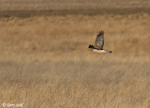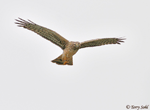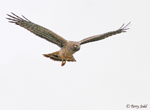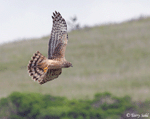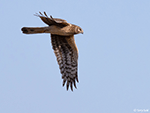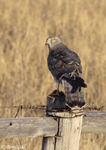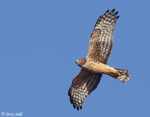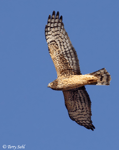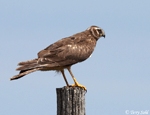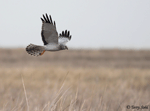| Length: 18 - 22 inches | Wingspan: 40 - 48 inches | Seasonality: All Seasons |
| ID Keys: White rump patch in flight, long black-tipped wings, long tail | ||
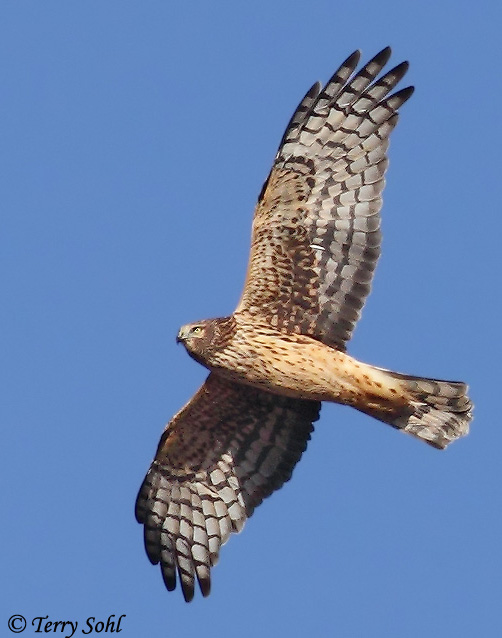 Often seen flying low and slow over fields in
search of prey, a Northern Harrier in flight can be easily identified both by
the unique hunting style, and by an easily seen white rump patch. They
were formerly known as the Marsh Hawk, a well-deserved name in parts of
their range given the preference for hanging out near large expanses of
herbaceous wetland. A bird of the open country, they shun forested areas,
and even tend to avoid perching in clumps of trees such as shelterbelts or
riparian areas.
Often seen flying low and slow over fields in
search of prey, a Northern Harrier in flight can be easily identified both by
the unique hunting style, and by an easily seen white rump patch. They
were formerly known as the Marsh Hawk, a well-deserved name in parts of
their range given the preference for hanging out near large expanses of
herbaceous wetland. A bird of the open country, they shun forested areas,
and even tend to avoid perching in clumps of trees such as shelterbelts or
riparian areas.
Habitat:
As the former name implies, it is often found in marshes or sloughs, especially in the eastern parts of their range or in the Prairie Potholes region where extensive cattail wetlands are common. However, further west they are also often found in dryer habitats, including dryland prairie and farm fields.
Diet:
Small mammals, birds, snakes, frogs, and large insects.
Behavior:
Typically hunts by low, deliberate flights over fields and open lands, a behavior that makes identification of the species often possible even if the bird is seen from a distance. Unlike many raptors, they are capable of hovering when prey is spotted. Their unique facial disks are thought to aid Northern Harriers in identifying prey by sound, while most hawks hunt primarily by sight alone.
Nesting:
May through June in South Dakota. The nest of a Northern Harrier is built on the ground, typically in dense vegetation such as near shrubby vegetation, amongst cattails or other wetland vegetation, or amongst thick clumps of grass. The male and female both help to construct the nest, although the female typically does the final nest construction. The main structure of the nest is based on cattails, bulrushes, willow stems, or other thicker pieces of vegetation, and then lined with grasses and other finer herbaceous material. The female lays 3 to 6 eggs, and she alone incubates them. Males however do provide food for the female, and for the young after they hatch. The incubation period is around 30 days.
Song:
Piercing whistles and high thin calls.
- Click here to hear the call of a circling female Northern Harrier, recorded in Larimer County, Colorado.1
- Click here to hear the scolding calls of a female Northern Harrier that had been near a nest site, recorded in British Columbia.2
Migration:
Northern populations do migrate, but southern populations may be semi-permanent residents. It's not clear if some Northern Harriers that overwinter in South Dakota are permanent residents, or are birds moving down from further north and replacing birds that summer in South Dakota but migrate further south for the winter.
Interactive eBird map:
Click here to access an interactive eBird map of Northern Harrier sightings
Similar Species:
If seen well, Northern Harriers have a unique shape, plumage, and behavior, but they could potentially be confused with the following species:
- Rough-legged Hawk - Both share the white rump plainly visible in flight, but Rough-legged Hawks have a much more broad tail profile in flight than a Northern Harrier, have a much shorter tail, lack the facial disks that give the Northern Harrier something of an owl-like appearance, and are substantially larger and more broad.
- Cooper's Hawk - Juvenile Cooper's Hawks in particular may look superficially similar to a Northern Harrier from a distance, but behavioral differences are evident, with Northern Harriers using their typical slow, low flights while searching for food, and Northern Harriers have faster more direct flight.
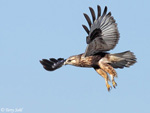 |
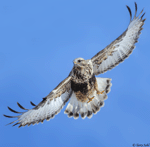 |
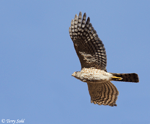 |
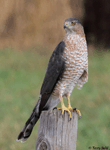 |
| Rough-legged Hawk | Rough-legged Hawk | Cooper's Hawk | Cooper's Hawk |
Conservation Status:
Seems to be declining in parts of its range when measured with Christmas Bird Count or Breeding Bird Survey data, possibly because of loss of wetland habitat and/or pesticide use. However, overall populations are still strong, as they are found across a very broad geographic area and are common in parts of their range. The IUCN considers the Northern Harrier to be a species of "least concern".
Further Information:
- USGS Patuxent Bird Identification InfoCenter, Northern Harrier
- WhatBird - Northern Harrier
- Audubon Guide -Northern Harrier
Photo Information:
November 26th, 2008 - Fort Pierre National Grasslands, South Dakota - Terry Sohl
Additional Photos:
Click on the image chips or text links below for additional, higher-resolution Northern Harrier photos.
Audio File Credits:
- 1Nick Komar, XC279717. Accessible at www.xeno-canto.org/279717
- 2James Bradley, XC326879. Accessible at www.xeno-canto.org/326879
| Click on the range map for a higher-resolution view |
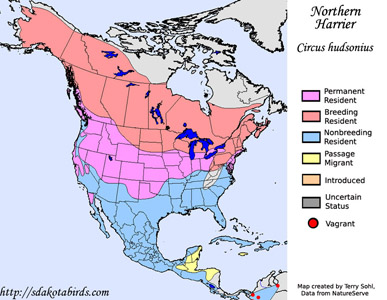 |
| South Dakota Status: Uncommon migrant and summer resident. Uncommon in winter in the south, rare in the north. |
Additional Northern Harrier Photos
Click for a higher-resolution version of these photos

